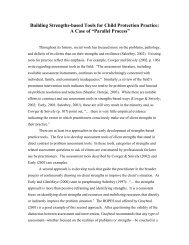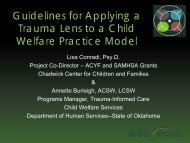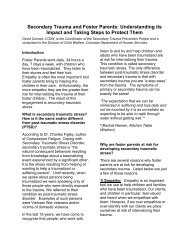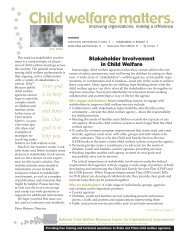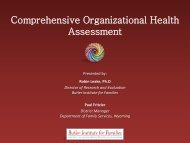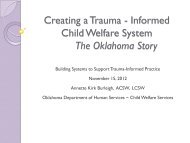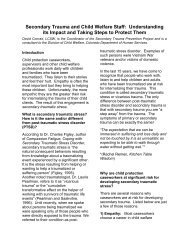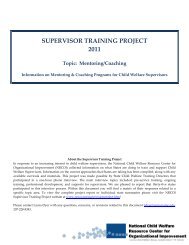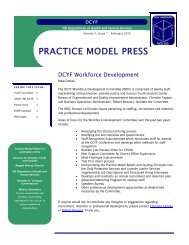Building a Model and Framework for Child Welfare Supervision
Building a Model and Framework for Child Welfare Supervision
Building a Model and Framework for Child Welfare Supervision
You also want an ePaper? Increase the reach of your titles
YUMPU automatically turns print PDFs into web optimized ePapers that Google loves.
managers, state foster care managers, <strong>Child</strong>ren’s Bureau staff, recruitment <strong>and</strong> retention<br />
grantees, <strong>and</strong> the Southern Regional Quality Improvement Center. Based on consultation with<br />
the working group <strong>and</strong> a comprehensive review of the literature in child welfare practice <strong>and</strong><br />
supervision <strong>and</strong> other relevant fields, a list of supervisory responsibilities was developed. This<br />
list became a core component of a protocol used to interview frontline practitioners, supervisors,<br />
<strong>and</strong> administrators regarding their perspectives about the relative importance of these<br />
responsibilities <strong>and</strong> the obstacles to <strong>and</strong> supports of effective child welfare supervision.<br />
Additional in<strong>for</strong>mation was collected through interviews with other experts in child welfare<br />
supervision <strong>and</strong> a survey of the National <strong>Child</strong> <strong>Welfare</strong> Resource Center <strong>for</strong> Organizational<br />
Improvement’s Peer Training Network members. The data collected from these sources <strong>and</strong><br />
ongoing consultation with working group members resulted in an emerging model <strong>for</strong> <strong>and</strong> an<br />
organizational framework to support effective supervision in child welfare. Further detail<br />
concerning the methodology is provided in Section III.<br />
Organization of this Report<br />
This report, <strong>Building</strong> a <strong>Model</strong> <strong>and</strong> <strong>Framework</strong> <strong>for</strong> <strong>Child</strong> <strong>Welfare</strong> <strong>Supervision</strong>, is organized into<br />
three sections. Section I introduces the following seven elements of an emerging model of<br />
supervision in child welfare:<br />
• the organization’s practice philosophy <strong>and</strong> approaches, clearly articulated in writing, <strong>and</strong><br />
the statutory <strong>and</strong> policy requirements that shape agency practice;<br />
• the identification of the functions <strong>and</strong> current job responsibilities of child welfare<br />
supervisors <strong>and</strong> acknowledgement of similarities <strong>and</strong> differences in staff members’<br />
perceptions of the relative importance of those responsibilities;<br />
• the centrality of building <strong>and</strong> maintaining supervisors’ relationships with their<br />
supervisees as well as with others in the organization <strong>and</strong> community to carrying out<br />
their responsibilities effectively;<br />
• the necessity <strong>for</strong> explicit <strong>and</strong> manageable st<strong>and</strong>ards <strong>for</strong> caseload size <strong>and</strong> supervisorsupervisee<br />
ratios;<br />
• specific expectations with regard to the frequency <strong>and</strong> <strong>for</strong>mat <strong>for</strong> supervision;<br />
• the organization’s expectations <strong>for</strong> ongoing evaluation of frontline practitioners;<br />
• support <strong>for</strong> supervisors in their roles as unit leaders <strong>and</strong> change agents.<br />
Section II presents an integrated organizational framework consisting of four components<br />
required to empower child welfare supervisors to effectively carry out their administrative,<br />
educational, <strong>and</strong> supportive functions. These components include:<br />
• an organizational culture that values <strong>and</strong> demonstrates support <strong>for</strong> the vital role<br />
supervisors play in ensuring positive outcomes <strong>for</strong> children, youth <strong>and</strong> families;<br />
• a model of supervisory practice that reflects how the organization views the roles,<br />
responsibilities, <strong>and</strong> expectations of supervisors <strong>and</strong> includes accurate, written job<br />
descriptions;<br />
• systematic recruitment <strong>and</strong> retention of individuals who are a “good fit” as frontline<br />
practitioners <strong>and</strong> supervisors <strong>and</strong>;<br />
4




